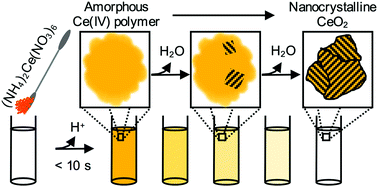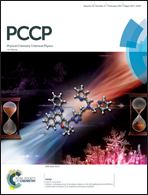Crystallization kinetics of cerium oxide nanoparticles formed by spontaneous, room-temperature hydrolysis of cerium(iv) ammonium nitrate in light and heavy water†
Abstract
A stable sol of cerium oxide nanoparticles forms spontaneously when cerium(IV) ammonium nitrate (CAN) is dissolved in room-temperature water at mM concentrations. Electron microscopy experiments reveal the formation of highly crystalline cerium oxide particles several nm in diameter and suggest that they are formed from amorphous particles that are similar in size. Under the low pH conditions of the experiments, the nanoparticles form a stable dispersion and show no evidence of aggregation, even many months after synthesis. The absence of particles large enough to scatter light significantly makes it possible to observe the crystallization kinetics through dramatic changes in the UV-visible absorption spectra that occur during solution aging. Measurements show that the cerium oxide nanocrystals are formed roughly an order of magnitude more slowly in D2O than in H2O solution. This large solvent kinetic isotope effect (kH/kD ∼ 10), which is reported here for the first time for the crystallization of a solid metal oxide phase, indicates a rate-determining proton transfer reaction, which is assigned to the conversion of hydroxy to oxo bridges. In D2O solution, the absorption per mole of cerium ions increases by over 400% at 290 nm as the weakly absorbing precursor phase is transformed into nanocrystalline cerium oxide. An isosbestic point is detected at 368 nm, and the absorption spectra can be modeled throughout aging by the sum of spectra of just two interconverting species. Preliminary ultrafast transient absorption experiments confirm that the optical properties of the amorphous precursors differ greatly from those of the final, nanocrystalline phase. Crystallization of CeO2 from CAN in water has much in common with the crystallization of iron oxides from iron(III) salts, including the importance of non-classical nucleation and growth pathways. It is an outstanding system for studying the poorly understood events that cause molecularly solvated ions to self-assemble into nanocrystals, following hydrolysis. At the same time, the strong susceptibility of CAN to spontaneously form CeO2 nanocrystals under the mildest of reaction conditions indicates that caution is needed when working with this common sacrificial oxidant.

- This article is part of the themed collection: 2017 PCCP HOT Articles


 Please wait while we load your content...
Please wait while we load your content...